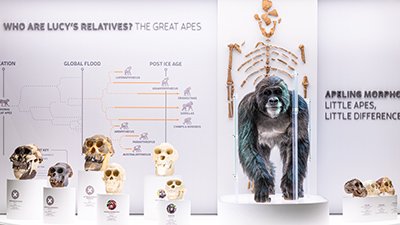
Lucy on the Ground With High Heels
ScienceNOW: “Lucy Had a Spring in Her Step” “Lucy,” the name given to partial australopithecine remains found in Ethiopia in 1974, may seem like old news. But new research suggests that “if Lucy were alive today, she could fit in high heels or march for miles without breaking her feet”—evidence, researchers claim, that Lucy was an experienced upright walker.
As one of the most well-known icons of evolution, Lucy has been the subject of considerable creationist scrutiny. Scientists have pointed out that most of Lucy’s features, especially her head and jaw, are distinctly apelike, with wrist bones suggesting she walked on all fours. These observations are difficult to reconcile with the claim that her pelvis and leg bones are evidence of upright walking, although creationists have attacked that claim as speculative. And, of course, the general incompleteness of Lucy’s skeleton casts doubt on the certainty of any interpretation.
A new analysis of 35 other australopithecine fossils sheds light on how Lucy may have walked, according to scientists who report their findings in the journal Science. The fossils are also from Ethiopia and, by piecing fragments together, the researchers believe they now understand the skeletal structure of Australopithecus afarensis feet. “The way the two ends of the bone were twisted in relation to each other in the fossils suggests that when one end was on the ground, the other end was raised about 8˚ to attach to the rest of the foot,” ScienceNOW reports (emphasis ours), the implication being that A. afarensis feet had well-formed arches like humans’. The researchers therefore conclude that Lucy and other australopithecines spent most of their time walking upright.
Some scientists disagree with the study’s conclusions, however. American Museum of Natural History paleoanthropologist Will Harcourt-Smith argues that the study does not settle the question of whether Lucy had crucially important arches on the inner foot. “It’s hard to envisage an animal that had entirely made the leap to full, obligate bipedalism,” he explained. (A composite photo in the National Geographic News coverage of the story helps illustrate Harcourt-Smith’s point, albeit unintentionally.)
This interpretive layer thickens the less complete a fossil is, and Lucy is a perfect example of that.
As with many high-profile fossils, a layer of interpretation lies between what the creature was really like and our idea of what the creature was like. This interpretive layer thickens the less complete a fossil is, and Lucy is a perfect example of that. Even if australopithecines sported an arched foot, it does not mean they were our ancestors; even if the outer portion of some australopithecines’ feet were arched, it does not mean their entire foot was; even if certain foot bones were twisted in a certain manner, it only “suggests” the outer portion of their feet was arched; and so on—at each step, the scientists have made a jump from the evidence to the conclusion. Moreover, how partial and interpretation-laden are the 35 fossils used in this analysis, and how certain is their connection to Lucy?
For more information:
Remember, if you see a news story that might merit some attention, let us know about it! (Note: if the story originates from the Associated Press, Fox News, MSNBC, the New York Times, or another major national media outlet, we will most likely have already heard about it.) And thanks to all of our readers who have submitted great news tips to us.
(Please note that links will take you directly to the source. Answers in Genesis is not responsible for content on the websites to which we refer. For more information, please see our Privacy Policy.)

Answers in Genesis is an apologetics ministry, dedicated to helping Christians defend their faith and proclaim the good news of Jesus Christ.
- Customer Service 800.778.3390
- Available Monday–Friday | 9 AM–5 PM ET
- © 2025 Answers in Genesis


